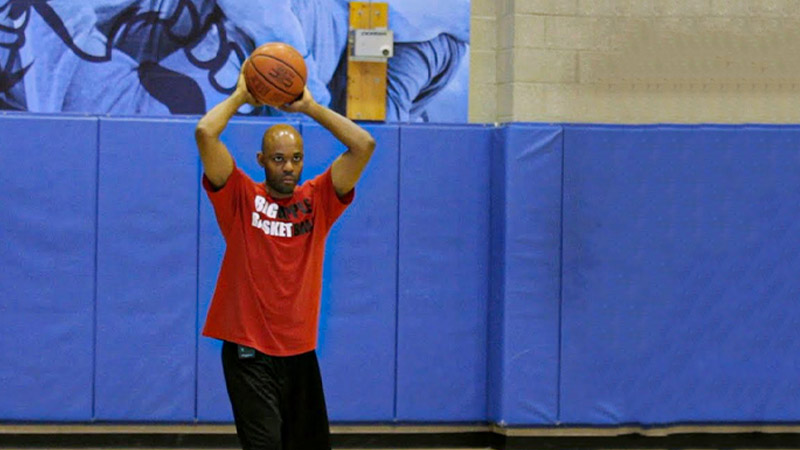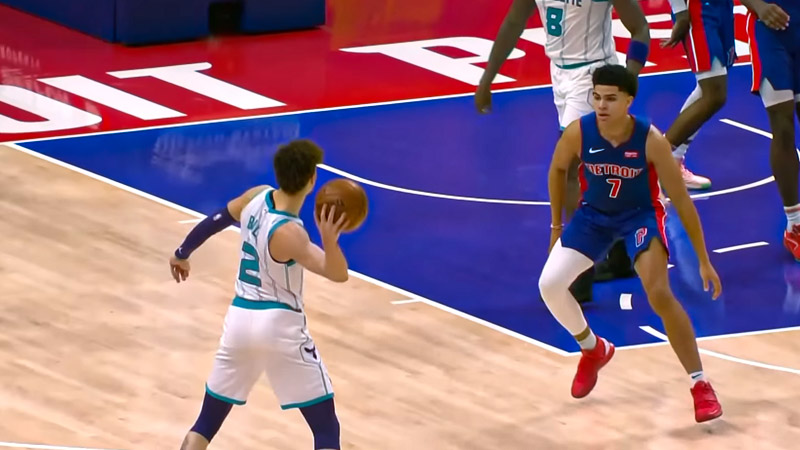Basketball is a dynamic sport that relies heavily on effective passing to create scoring opportunities and move the ball around the court. Mastering various types of passes is crucial for players at all levels.
Each pass has its unique purpose and execution, and understanding when and how to use them can elevate a player’s game. In this blog post, we will explore different types of basketball passes, their descriptions, and the situations in which they are necessary.
Whether you’re a beginner learning the fundamentals or an experienced player looking to enhance your passing skills, this guide will provide valuable insights into the art of passing in basketball.
15 Common Types of Basketball Pass
Here are the all essential details of the most common basketball passes:
1. Chest pass
The chest pass is a fundamental basketball pass used to quickly and accurately move the ball to a teammate. The player grips the ball with both hands at chest level, elbows out, and forcefully extends the arms forward to propel the ball toward the intended recipient.
It is ideal for fast breaks, perimeter passing, and passing in traffic. The chest pass is efficient and reliable, ensuring the ball reaches its target swiftly.
This pass requires proper technique and timing, as well as good communication with teammates. It should be used when a direct, quick, and accurate pass is required, especially in situations where defenders are nearby or there is limited space to make a pass.
2. Bounce pass
The bounce pass is a low pass executed by bouncing the ball off the floor to reach the intended receiver. To perform a bounce pass, hold the ball with both hands at waist level, and with a quick snap of the wrists, push the ball downward towards the floor.
It should hit the floor about two-thirds of the way between you and the receiver, allowing the ball to bounce up into their hands. The bounce pass is useful when defenders are in the passing lane or when there’s limited space to make a direct pass.
It requires accuracy and proper timing to avoid turnovers. This pass is effective for delivering the ball to a teammate in a low and quick manner, making it harder for defenders to intercept.
3. Overhead pass

The overhead pass, also known as the two-handed pass, involves using both hands to pass the ball from an elevated position above the head. This pass is effective for making longer, cross-court passes or when the passer needs to see over defenders.
To execute an overhead pass, grip the ball firmly with both hands, extend the arms fully overhead, and release the ball with a flick of the wrists.
The overhead pass provides good accuracy and allows for a clear line of sight to the intended target. It requires proper timing and technique to avoid interceptions and should be used when a direct passing lane is obstructed or when the passer has a height advantage over defenders.
It is suitable for making accurate, high-arching passes over defenders or delivering the ball quickly to a teammate on the move.
4. Wraparound pass
The wraparound pass is a creative and deceptive basketball pass where the player wraps the ball around a defender to reach a teammate. This pass is particularly useful when a defender is guarding the direct passing lane or when the passing angle is limited.
To execute a wraparound pass, the player extends one arm around the side of the defender while simultaneously tucking the ball against their body with the other hand.
The passer then quickly releases the ball from the tucked position, creating an arc around the defender to find an open teammate. This pass requires good ball-handling skills, court awareness, and precise timing.
It is an effective tool for surprising defenders and creating scoring opportunities for teammates. The wraparound pass should be used sparingly and with caution, as it carries a higher risk of turnovers if not executed properly.
5. Lob pass
The lob pass is an aerial pass thrown high above the defenders’ reach to allow a teammate to catch the ball near the basket for a shot or a dunk. It is used when there is a height advantage or a clear path to the basket.
The passer throws the ball with an upward trajectory using a gentle arc to give the receiver time to position themselves and make the catch. Timing and accuracy are crucial in executing a successful lob pass.
It is often used on fast breaks, alley-oop plays, or when the offensive player has gained an advantageous position near the basket.
The lob pass requires good communication and understanding between the passer and the receiver, as well as precise judgment of distance and timing.
6. Behind-the-back pass

The behind-the-back pass is a flashy and creative pass that adds flair to the game. It involves throwing the ball behind the passer’s back to a teammate. To execute this pass, the player uses their dribbling hand to wrap the ball around their back, releasing it with a flick of the wrist.
The behind-the-back pass can be effective in situations where defenders are closely guarding the passer and it provides an unexpected angle to get the ball to an open teammate.
However, it requires skill, timing, and awareness of the surrounding players to avoid turnovers or intercepted passes. It is important to use this pass judiciously and prioritize accuracy over showmanship.
7. No-look pass
The no-look pass is a deceptive pass that involves faking a pass in one direction while quickly delivering the ball in another direction, all without looking at the intended recipient. It requires a high level of court vision and trust in teammates.
The player uses their eyes and body movements to deceive defenders before delivering the pass. It can be an effective way to catch opponents off-guard and create scoring opportunities. However, it is a high-risk pass as it relies heavily on anticipation and timing.
Precision and familiarity with teammates’ movements are essential to execute the no-look pass successfully. It is a skill that is typically reserved for experienced and skilled players who have a strong understanding of their teammates’ positioning and tendencies.
8. Alley-oop pass
The alley-oop pass is an exciting and crowd-pleasing play that involves throwing the ball towards the rim for a teammate to catch and score in mid-air. It is commonly used for high-flying players who excel in dunking.
The passer needs to throw the ball with precise timing and accuracy, allowing the recipient to catch it in stride and finish with a spectacular slam dunk.
The alley-oop pass requires good communication, understanding, and chemistry between the passer and the recipient. It is often used in fast breaks or half-court plays near the basket to take advantage of height or athleticism.
However, it is essential to use the alley-oop pass judiciously, as mistimed or inaccurate passes can result in turnovers or missed opportunities.
9. Outlet pass
The outlet pass is a quick and long-distance pass made by a rebounder or an inbounding player after a defensive rebound or an opponent’s made basket. It is designed to initiate a fast break or start a quick offensive transition.
The passer immediately looks for an open teammate who is ahead of the defense and throws a long pass to get the ball up the court quickly.
The outlet pass requires accuracy, speed, and awareness of the teammates’ positions on the court. It is important for the recipient of the pass to anticipate and adjust their position accordingly to receive the ball and initiate the offensive play.
The outlet pass is a crucial element in fast-paced basketball, as it can catch opponents off-guard and lead to easy scoring opportunities.
10. Touch pass
The touch pass is a quick and accurate pass that is executed with a deft touch, often with one hand or fingertips. It is used to keep the ball moving fluidly between teammates and to exploit gaps in the defense.
The touch pass is especially effective when players are in motion or when the passer is under pressure from defenders.
It requires excellent hand-eye coordination and a delicate touch to control the ball’s speed and direction. The pass is made by lightly tapping or flicking the ball to a teammate, allowing for a seamless continuation of the offensive play.
The touch pass can be used in various situations, such as cutting to the basket, changing the direction of the ball, or setting up a teammate for a shot. It adds speed and unpredictability to the offense and often catches defenders off-guard.
11. Baseball pass
The baseball pass is a long-distance pass that resembles a throw in baseball. It is typically used to quickly advance the ball from one end of the court to the other, bypassing the defense.
The passer throws the ball with an overhead motion, similar to a baseball throw, using one or both hands.
The baseball pass requires strength, accuracy, and good judgment to gauge the distance and timing. It is commonly used in fast breaks, outlet situations, or when a teammate breaks away from defenders for an easy scoring opportunity.
The pass is particularly effective when there is limited time or space to make a traditional long pass. However, the baseball pass should be used selectively, as it carries a higher risk of turnovers or interceptions due to its long trajectory.
12. Over-the-shoulder pass
The over-the-shoulder pass is a flashy and creative pass used in situations where a traditional pass is not feasible due to defenders or obstacles.
This pass involves the passer quickly turning their back to the intended receiver, then tossing the ball over their shoulder with one hand while looking in the opposite direction. It requires excellent court vision, timing, and trust between teammates.
The over-the-shoulder pass is often utilized on fast breaks or when the passer is closely guarded and needs to quickly release the ball. It can be an effective way to surprise defenders and create scoring opportunities. However, it is a high-risk pass that requires practice and coordination to avoid turnovers.
13. Pick-and-roll pass
The pick-and-roll pass is a key component of the pick-and-roll offensive play, which involves one player setting a screen (pick) for a teammate who then drives to the basket or shoots. As the ball-handler comes off the screen, they must read the defense and make a quick decision to either drive, shoot, or pass.
The pass in the pick-and-roll situation is often a quick and accurate delivery to the rolling player who is moving toward the basket after setting the screen. This pass requires good communication, timing, and court awareness.
The passer must assess the defense and make a precise pass to avoid turnovers or defensive traps. The pick-and-roll pass is essential in creating scoring opportunities by manipulating the defense and forcing them to make choices.
14. Skip pass
The skip pass is a long, cross-court pass that quickly moves the ball from one side of the court to the other, bypassing defenders in the process. This pass is effective when the defense collapses toward the ball, leaving a teammate open on the opposite side. To execute a skip pass, the passer must have strong arm strength and accuracy.
The pass must be swift and zipped across the court to avoid interceptions. The skip pass is useful in breaking down zone defenses or when the offense needs to find an open shooter on the weak side.
It requires good court vision and the ability to anticipate defensive rotations. The passer should be aware of the defensive positioning and make the pass at the right time to exploit the open space.
15. Bullet pass
The bullet pass is a powerful and fast pass that allows the ball to reach its target rapidly. This pass is characterized by a strong one-handed throw with a quick flick of the wrist, generating high velocity. It is commonly used in situations where there is a short passing window or when the defense is tight.
The bullet pass can help break through defenders and create scoring opportunities. It requires excellent arm strength and accuracy to avoid turnovers. This pass is particularly useful in transition plays or when trying to hit a cutting player for a layup.
However, the bullet pass can be risky if not properly executed, as it can lead to deflections or interceptions. It is essential to assess the passing lanes, anticipates defensive reactions, and make quick decisions when attempting a bullet pass.
FAQs
What is the most commonly used pass in basketball?
The chest pass is the most commonly used pass in basketball. It involves gripping the ball with both hands at chest level and forcefully pushing it toward the intended recipient. The chest pass is quick, accurate, and effective for fast breaks, perimeter passing, and passing in traffic.
When should I use a bounce pass?
A bounce pass is useful when defenders are in the passing lane or when there’s limited space to make a direct pass. Bouncing the ball off the floor reduces the chance of interception and allows the ball to reach the recipient at a lower height, making it easier for them to catch.
How is the alley-oop pass executed?
The alley-oop pass is an exciting play where a player throws the ball near the rim for a teammate to catch and finish with a dunk or layup. It requires good timing, coordination, and communication between the passer and the recipient, who must anticipate the pass and position themselves near the basket for the finish.
What is a skip pass used for?
A skip pass is a long, cross-court pass that quickly moves the ball from one side of the court to the other, bypassing defenders. It is effective in breaking down zone defenses or when the offense needs to find an open shooter on the weak side.
How is the pick-and-roll pass executed?
In the pick-and-roll play, the ball-handler passes to a teammate who sets a screen (pick) and rolls to the basket. The pass is typically a quick and accurate delivery to the rolling player, who is moving toward the basket. It requires good communication, timing, and court awareness to create scoring opportunities.
Wrapping Up
Mastering the different types of basketball passes is essential for any player looking to excel on the court. Each pass has its purpose and situation where it is most effective. The chest pass provides a quick and accurate means of moving the ball, while the bounce pass avoids defenders and tight spaces.
The alley-oop pass adds excitement and opportunities for high-flying finishes. Skip passes break down zone defenses, and pick-and-roll passes create scoring chances through effective screens.
By understanding these passes and practicing their execution, players can elevate their passing skills, improve team plays, and create a more fluid and dynamic offense.
So, whether you’re a point guard, shooting guard, or a big man in the paint, incorporating these passes into your game will make you a more versatile and effective player on the basketball court. Best wishes.







